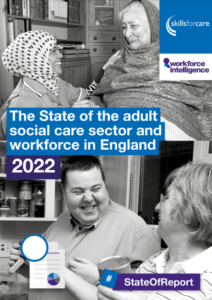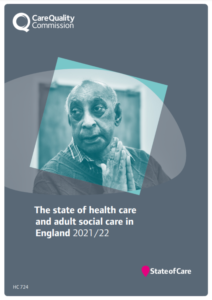Carterwood work closely with many leading sector bodies, sharing the data and insight that empowers our team to better advise clients and fuels improvements within our advisory services and our platforms for market analysis: Carterwood Analytics.
Here we explore the key messages from two recently published reports with a focus on the sector and its workforce as we race towards an undoubtedly challenging 2023.
Skills for Care – ‘The state of the adult social care sector and workforce in England 2022’
This report provides a comprehensive analysis of the adult social care workforce in England, totalling 1.50 million people, exploring trends in workforce supply and demand, employment information, recruitment and retention, demographics, pay, qualification rates and future forecasts.
- The level of staff recruitment has increased 52% on the previous year, with 165,000 vacant posts (from 55,000 posts) – the highest number of vacancies since records began (2012-13).
- Turnover has remained reasonably stable, despite the increase in vacancies, indicating ineffective/unsuccessful recruitment to replace the proportion of staff leaving and to staff new roles
- The median hourly rate for care workers decreased, in real terms, by 1.5% between March 2021 and March 2022, despite the increase in the national living wage, likely driven by the high cost of living in 2021/22 with inflation rising to 7.0%.
- 11% of workers new to their role within the year had also arrived in the UK within the year (between February and August 2022), which was greater than the equivalent period in 2021 (4%) and 2020 (2%).
- Employee investment reaps rewards as employers with favourable workforce metrics (such as high levels of learning and development), on average, had better outcomes (lower staff turnover and/or high CQC ratings).
Click here to view the report in full
Care Quality Commission – ‘The state of health care and adult social care in England 2021/22’
This annual report assesses the state of health care and social care in England, explores sector trends, shares examples of best practice and highlights essential improvement needed.
- Occupancy is on the rise, but yet to return to pre-pandemic levels – experimental data published by ONS using CQC’s provider information returns shows that 77.8% of care home beds were occupied between March 2021 and February 2022, with more recent data for August 2022 up to 82.5%, both still below the pre-pandemic occupancy rates of 84.7% (August 2019 to February 2020).
- There was a 2.4% reduction in the number of registered care homes between March 2021 and August 2022. The South East had the biggest reduction in the number of care homes (96 fewer locations); however, proportionally the reduction was greatest in the South West (a reduction of 3.7%, amounting to 75 locations).
- Staff costs as a percentage of turnover rose by 3.8 percentage points between September 21 and March 22.
- Agency staff costs made up 13.2% of total staff costs by the end of March 2022, an increase of 4 percentage points from the end of March 2020.
- In July 2022 only 4 in 10 patients were able to leave hospital when they were ready, largely due to severe staff shortages in adult social care, resulting in almost 13,000 patients a day spending more time in hospital than needed.
Click here to view the report in full
Market analysis for the elderly care home sector
Carterwood’s team of specialists provide independent, expert analysis that helps operators, developers and investors to improve decision-making within the elderly care home sector.
- Commercial due diligence
- Planning
- Market intelligence
- Portfolio performance
We’ve analysed over 1,800 elderly care homes markets and work with 80% of the top 20 elderly care home operators in the UK. Get in touch today to discover how we can help you achieve your goals for 2023 and beyond.
Find out more about our specialist reports for the elderly care home sector
Image sources: Skills for care and Care Quality Commission









